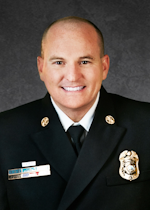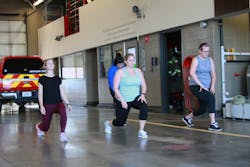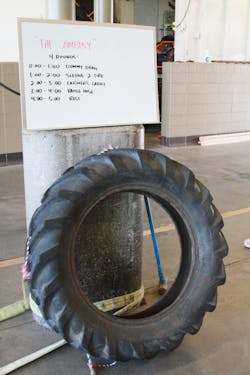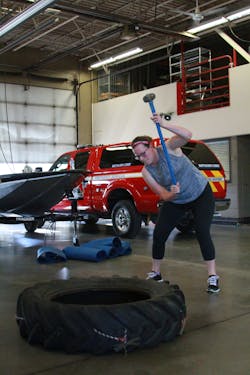Health & Wellness: Fitness for Community Engagement
If your fire department is looking for a new way to connect with the citizens in your community, you may want to step outside the box of traditional public education programs and events and try the latest trend in community outreach—hosting group fitness classes at the firehouse. Yes, as crazy as it sounds, this approach in community engagement is proving to be popular among the residents of one fire department in the Midwest.
For over a year now, the Olathe, KS, Fire Department has been garnering community support and participation from its residents with its Fit with Fire group fitness program. Twice a week for six weeks, program participants experience challenging one-hour workouts that simulate fireground activities and incorporate educational components geared toward learning about Olathe Fire Department culture. What makes the program so unique is that the classes are led by certified fire department fitness trainers and held on site at the firehouse.
Background on the City of Olathe
The fourth largest city in the region, Olathe is a growing suburban community of 140,000 residents located in the Kansas City metropolitan area. Olathe has a Class 1 Insurance Services Office (ISO) public protection rating, and the department is accredited through the Commission on Fire Accreditation International.
As a progressive fire service agency that prides itself on innovation and continuous improvement, the Olathe Fire Department is constantly looking for creative ways to network with the public and share its values and culture beyond service delivery. The Fit with Fire program is an example of this spirit of innovation and community collaboration.
Origins of Fit with Fire
In 2017, after reading about a group fitness class offered to campus students by the University of California – Davis Fire Department, Olathe Fire Chief Jeff DeGraffenreid had the idea of implementing a similar program. Recognizing the value of internal partnerships, DeGraffenreid decided to team with the Olathe Parks and Recreation Department (OPRD), which already had a successful model in place for promoting fitness classes at the local community center. Additionally, OPRD’s seasonal activity guide provided a platform for marketing the idea to the public.
To develop the group fitness class, DeGraffenreid approached two shift captains—Matt Britt and Paul Craft—who at the time were conducting group workouts with the crews at Olathe Fire Station 51, nicknamed “51 Fit.” Their workouts included exercise stations where firefighters would perform tire flips, sledgehammer swings, kettlebell carries and box jumps, and even drag rescue dummies and large diameter firehose. With Britt and Craft being ACE-certified peer fitness trainers, DeGraffenreid knew they would be a perfect match for designing and implementing the new fitness program.
Program basics
A typical Fit with Fire class resembles a boot camp-style workout. Participants arrive at Olathe Fire Station 51 to find the workout of the day (WOD) written on a dry erase board. The WOD always has a fire-related name or theme, which Britt and Craft use to educate the participants about fire department culture and/or nomenclature.
For example, “Ice Rescue” was a workout name chosen due to some ice rescue suits laying out drying from training that took place earlier in the day. Britt and Craft took the opportunity to talk about ice and water rescue operations, water safety, and weather safety.
Some other WOD names: “The Battalion,” “Rope Rescue,” “Accreditation,” “VEIS” and “Flow Path,” all of which have allowed Britt and Craft the opportunity to educate participants on topics like fire department span of control, technical rescue, service deployment, fireground tactics and even fire behavior. Britt and Craft said participants really enjoy this part of the class.
Every Fit with Fire WOD can be broken down into three sessions: the warm-up, the workout and the cool down.
The warm-up session usually consists of the following exercises:
- High knees
- Butt kicks
- Karaoke
- High skip
- Toy soldier
- Lunges
If the WOD involves working specific muscle groups, the following additional exercises may be incorporated into the warm-up session:
- Planks
- Sit-ups
- Push-ups
- Pull-ups
- Air squats
- Bootstrappers
- Warrior squats
- Alternating Spiderman lunge with reach
Britt and Craft try to keep the workouts relevant to firefighter time domains, offering teaching points on rules of air management, recycling and rehab. For example, some workouts involve 15–20 minutes of constant work, focusing on slower methodical aerobic activity, while other workouts consist of 2–4 minutes of high-intensity/short-interval work with equal rest periods that repeat for several rounds. Either way, each WOD contains a blend of conventional exercises and other movements specifically intended to simulate fireground activities.
Examples of conventional exercises along with their purpose:
- Air squats – leg and core work
- Box jumps – leg and core work
- Burpees – full-body cardiovascular movement
- Kettlebell swings – full-body work that engages the core, glutes and hamstrings
- Med ball cleans – full-body work that engages the core, hip flexors and glutes
- Pull-ups/ring rows – upper body strength work
- Push-ups – upper body strength work
- Sit-ups – core work
- Step ups – leg work
Examples of exercises that use fire equipment and/or simulate fireground activities:
- Battle hoses – Similar to battle ropes, but instead uses 1¾-inch hose
- Dummy drag – Simulates dragging a firefighter or a victim
- Farmer’s walk/carry – A different size kettlebell in each hand, simulates carrying tools
- LDH hose drags – Full body work that engages upper body, legs, and core
- Med ball slams – Simulates axe swings and forcible entry work
- Sandbag drags/bear crawl – Odd object work
- Sandbag cleans –Odd object work
- Sledge to tire – Simulates axe swings and forcible entry work
- Stair climbs with kettlebells – Simulates carrying tools up stairs
- Couch stretch
- Pigeon pose
- Twisted cross
- Seated forward fold
- Seal stretch
- Child’s pose
Start your own program!
If your department is interested in developing a similar program for your community, here are few tips to get started.
- Get approval: Fire chief support and approval is a must for program success. Also, be sure to check into important factors such as legal implications and insurance coverage before getting started.
- Get buy-in: Getting organizational buy-in from all ranks is equally as important. With fitness classes being held onsite at the firehouse, firefighters will need be on board with the program. The best way is to get them involved, especially your fitness trainers and instructors.
- Get resourceful: Maximize the use of internal resources. Whether it be forming partnerships with your parks and recreation department to market your program or obtaining fitness equipment, such as used tractor tires from public works, capitalize on every available resource at your disposal.
At this point, you are ready to develop your own version of Fit with Fire. Determine your outreach goals and design a group fitness class that works best for your department and community. Once you have approval, buy-in, the necessary resources and a program template, it’s time to schedule your first class. What are you waiting for?

Kevin Weyand
Kevin Weyand is a 24-year veteran of the fire service and currently serves as the division chief of Special Operations for the Olathe Fire Department. His responsibilities include overseeing the department’s special operations group, emergency management and homeland security unit, mobile integrated healthcare unit, and health/wellness unit. If interested in learning more about the Fit with Fire program, email Weyand at [email protected].









